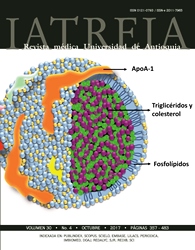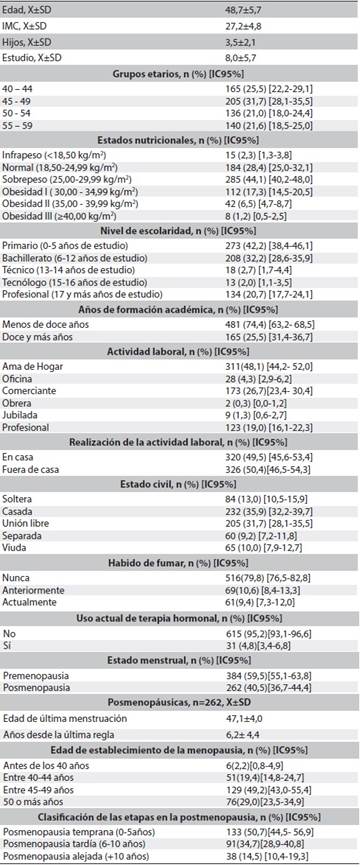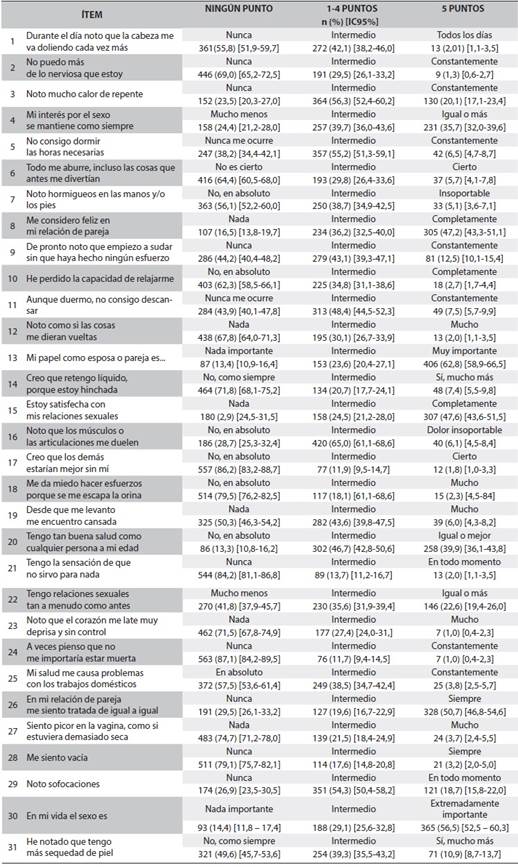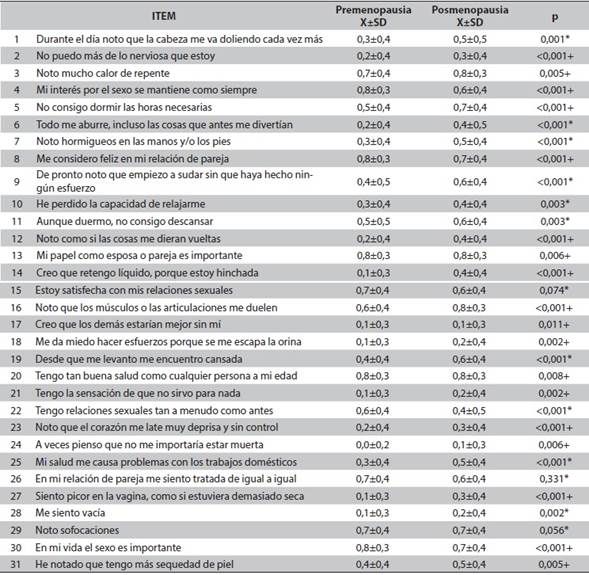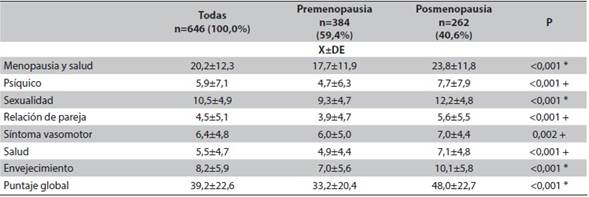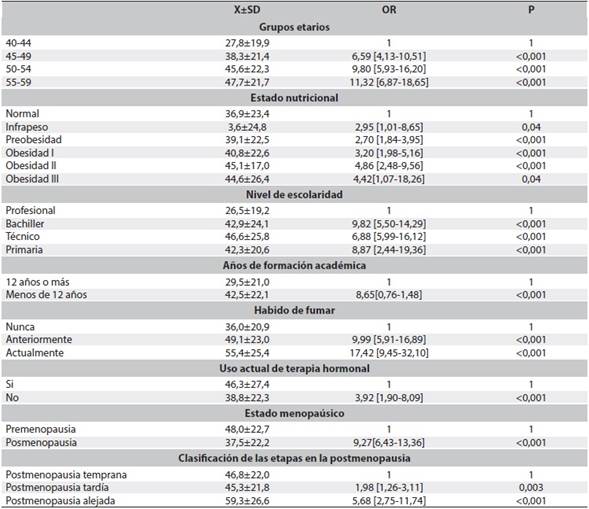Menopausal manifestations and quality of life in afro-colombians. Valuation whit Cervantes scale
DOI:
https://doi.org/10.17533/udea.iatreia.v30n4a03Keywords:
climacteric, menopause, quality of lifeAbstract
Introduction: the menopausal manifestations should be studied by ethnic considerations.
Objective: to identify the most prevalent menopausal manifestations and to evaluate quality of life according to menstrual states.
Methods: this study is a part of CAVIMEC [Quality of Life in Menopause and Colombian Ethnic Groups], performed with Cervantes Scale, which evaluates CV in menopause, in 646 Afro-Colombians, aged 40-59 years, living in populations of the Caribbean and Pacific.
Results: mean age 48.7±5.7 years, 69.1% with obesity/overweight, 22.7% with university/technological studies and 40.5% postmenopausal. The most prevalent manifestations: hot flashes 76.4%; suffocation 73.1%; Muscle/joint pain 71.3%; they couldn’t sleep 61.8%; easy sweating episode 55.8%; dry skin 50.4% and headache that increased during the day 44.2%. The third part could not be good by the nerves, things like boring, lost the ability to relax or noticed that everyone was spinning 24.4% had less interest in sex and 14.4% had not significant sexuality. Postmenopausal women had worse scores in most of the manifestations and in the domains of health, psychic, sexuality, relationship, vasomotor, health, aging and global.
Conclusion: hot flashes, suffocations and muscle/joint pain were the manifestations most prevalent, in seven out of ten. Postmenopausal women had worse quality of life.
Downloads
References
(1.) The WHOQOL Group. The World Health Organization Quality of Life Assessment (WHOQOL): development and general psychometric properties. Soc Sci Med. 1998 Jun;46(12):1569-85. DOI 10.1016/S0277-
(98)00009-4.
(2.) Hilditch JR, Lewis J, Peter A, van Maris B, Ross A, Franssen E, et al. A menopause-specific quality of life questionnaire: development and psychometric properties. Maturitas. 1996 Jul;24(3):161-75. Erratum in: Maturitas 1996 Nov;25(3):231.
(3.) Greene JG. Constructing a standard climacteric scale. Maturitas. 1998 May;29(1):25-31.
(4.) Berlin Center for Epidemiology and Health Research [Internet]. Berlin: MSR; 2008 [cited 2011 Sept 25]. MRS. The Menopause Rating Scale. Available from: http://www.menopause-rating-scale.info/about.htm
(5.) Palacios S, Ferrer-Barriendos J, Parrilla JJ, Castelo-Branco C, Manubens M, Alberich X, et al. [Healthrelated quality of life in the Spanish women through and beyond menopause. Development and validation of the Cervantes Scale]. Med Clin (Barc). 2004 Feb;122(6):205-11. Spanish.
(6.) Avis NE, Stellato R, Crawford S, Bromberger J, Ganz P, Cain V, et al. Is there a menopausal syndrome? Menopausal status and symptoms across racial/ethnic groups. Soc Sci Med. 2001 Feb;52(3):345-56.
(7.) Monterrosa A, Blumel JE, Chedraui P, Gomez B, Valdez C. Quality of life impairment among postmenopausal women varies according to race. Gynecol Endocrinol. 2009 Aug;25(8):491-7.
(8.) Monterrosa-Castro A. Calidad de vida en la menopausia y etnias colombianas. Primeros resultados del estudio CAVIMEC. Rev Colomb Menopaus. 2011;17(4):70-81.
(9.) Romero-Pérez IM, Monterrosa-Castro A, Paternina-Caicedo A. Menopausia y etnias/razas: ¿hay diferencias en la presentación de los síntomas? Rev Colomb Obstet Ginecol. 2010;61(4):319-328.
(10.) Miller SR, Gallicchio LM, Lewis LM, Babus JK, Langenberg P, Zacur HA, et al. Association between race and hot flashes in midlife women. Maturitas. 2006 Jun;54(3):260-9.
(11.) Freeman EW, Grisso JA, Berlin J, Sammel M, Garcia-Espana B, Hollander L. Symptom reports from a cohort of African American and white women in the late reproductive years. Menopause. 2001 Jan-Feb;8(1):33-42.
(12.) Gold EB, Sternfeld B, Kelsey JL, Brown C, Mouton C, Reame N, et al. Relation of demographic and lifestyle factors to symptoms in a multi-racial/ethnic population of women 40-55 years of age. Am J Epidemiol. 2000 Sep;152(5):463-73.
(13.) Departamento Administrativo Nacional de Estadísticas [Internet]. Bogotá: DANE [consultado 2016 Jul 23]. Estadísticas por tema: Demografía y Población. Disponible en: https://www.dane.gov.co/index.php/estadisticas-por-tema/demografia-y-poblacion
(14.) Colombia. Ministerio de Salud. Resolución Nº 008430 DE 1993 por la cual se establecen las normas científicas, técnicas y administrativas para la investigación en salud. Bogotá: El ministerio; Octubre 4 de 1993. Disponible en: http://www.urosario.edu.co/urosario_files/a2/a24fb07a-f561-4fcc-b611-affff4374bb7.pdf
(15.) Chedraui P, Aguirre W, Hidalgo L, Fayad L. Assessing menopausal symptoms among healthy middle aged women with the Menopause Rating Scale. Maturitas. 2007 Jul;57(3):271-8.
(16.) Coronado PJ, Sánchez-Borrego R, Ruiz MA, Baquedano L, Sánchez S, Argudo C, et al. Psychometric attributes of the Cervantes short-form questionnaire for measuring health-related quality of life in menopausal women. Maturitas. 2016 Feb;84:55-62. DOI 10.1016/j.maturitas.2015.10.013.
(17.) Gibson C, Matthews K, Thurston R. Daily physical activity and hot flashes in the Study of Women’s Health Across the Nation (SWAN) Flashes Study. Fertil Steril. 2014 Apr;101(4):1110-6. DOI 10.1016/j.fertnstert.2013.12.029.
(18.) Monterrosa-Castro A, Blumel JE, Chedraui P. Frecuencia y severidad de síntomas menopáusicos en una población de mujeres afrodescendientes colombianas. MedUnab. 2008;11(2):113-119.
(19.) Monterrosa-Castro A, Romero-Pérez I, Paternina-Caicedo A. Manifestaciones músculo-articulares, y no las oleadas de calor, es el síntoma más prevalente en mujeres climatéricas del Caribe colombiano. Salud Uninorte. 2010;26(2):179-88.
(20.) Pérez-López FR, Fernández-Alonso AM, Pérez-Roncero G, Chedraui P, Monterrosa-Castro A, Llaneza P. Assessment of menopause-related symptoms in mid-aged women with the 10-item Cervantes Scale. Maturitas. 2013 Oct;76(2):151-4. DOI 10.1016/j.maturitas.2013.07.002.
(21.) Dugan SA, Powell LH, Kravitz HM, Everson Rose SA, Karavolos K, Luborsky J. Musculoskeletal pain and menopausal status. Clin J Pain. 2006 May;22(4):325-31.
(22.) Buysse DJ, Reynolds CF 3rd, Monk TH, Berman SR, Kupfer DJ. The Pittsburgh Sleep Quality Index: a new instrument for psychiatric practice and research. Psychiatry Res. 1989 May;28(2):193-213.
(23.) Soldatos CR, Dikeos DG, Paparrigopoulos TJ. The diagnostic validity of the Athens Insomnia Scale. J Psychosom Res. 2003 Sep;55(3):263-7.
(24.) Monterrosa-Castro A, Marrugo-Flórez M, Romero-Pérez I, Fernández-Alonso AM, Chedraui P, Pérez-López FR. Assessment of sleep quality and correlates in a large cohort of Colombian women around menopause. Menopause. 2013 Apr;20(4):464-9. DOI 10.1097/gme.0b013e31826e7649.
(25.) Bocchino S. Aspectos psiconeuroendocrinos de la perimenopausia, menopausia y climaterio. Rev Psiquiatr Urug. 2005;70(1):66-79.
(26.) Monterrosa-Castro A, Márquez-Vega J, Arteta-Acosta C. Disfunción sexual en mujeres climatéricas afrodescendientes del Caribe Colombiano. Iatreia. 2014 Ene-Mar;27(1):31-41.
(27.) Blümel JE, Chedraui P, Baron G, Belzares E, Bencosme A, Calle A, et al. Sexual dysfunction in middle-aged women: a multicenter Latin American study using the Female Sexual Function Index. Menopause. 2009 Nov-Dec;16(6):1139-48. DOI 10.1097/gme.0b013e3181a4e317.
(28.) Styer AK. The impact of estrogen alone hormone therapy on breast cancer risk and health outcomes: reassurance for the treatment of climacteric symptoms in black women? Menopause. 2017 Feb;24(2):124-125. DOI 10.1097/GME.0000000000000821.
Published
How to Cite
Issue
Section
License
Copyright (c) 2017 Iatreia

This work is licensed under a Creative Commons Attribution-ShareAlike 4.0 International License.
Papers published in the journal are available for use under the Creative Commons license, specifically Attribution-NonCommercial-ShareAlike 4.0 International.
The papers must be unpublished and sent exclusively to the Journal Iatreia; the author uploading the contribution is required to submit two fully completed formats: article submission and authorship responsibility.


